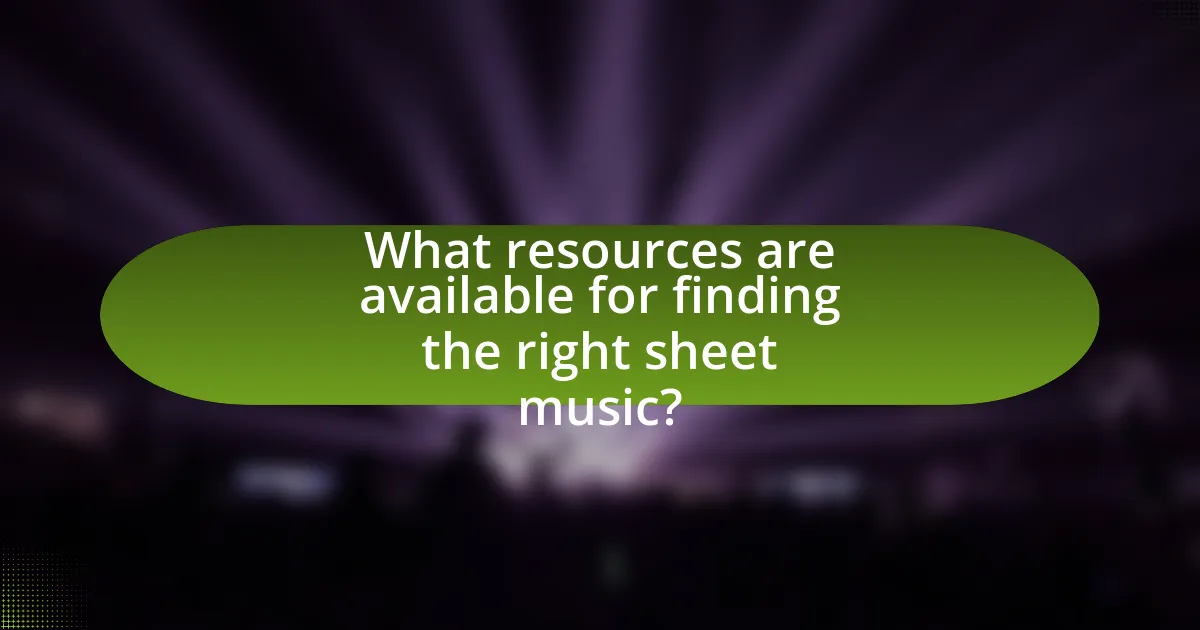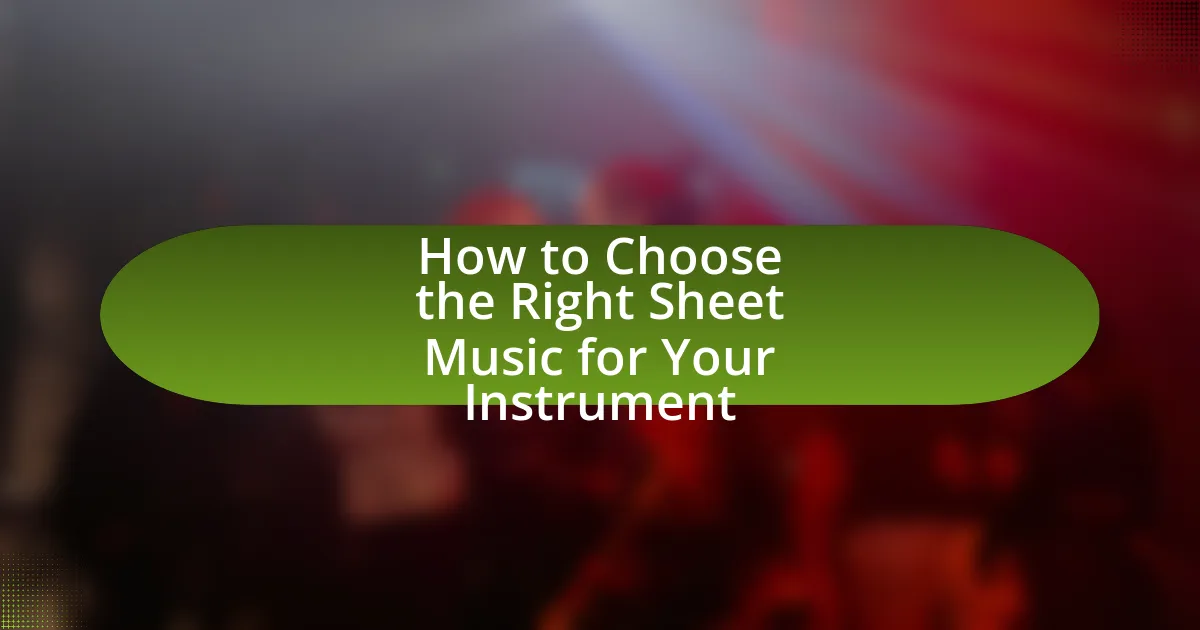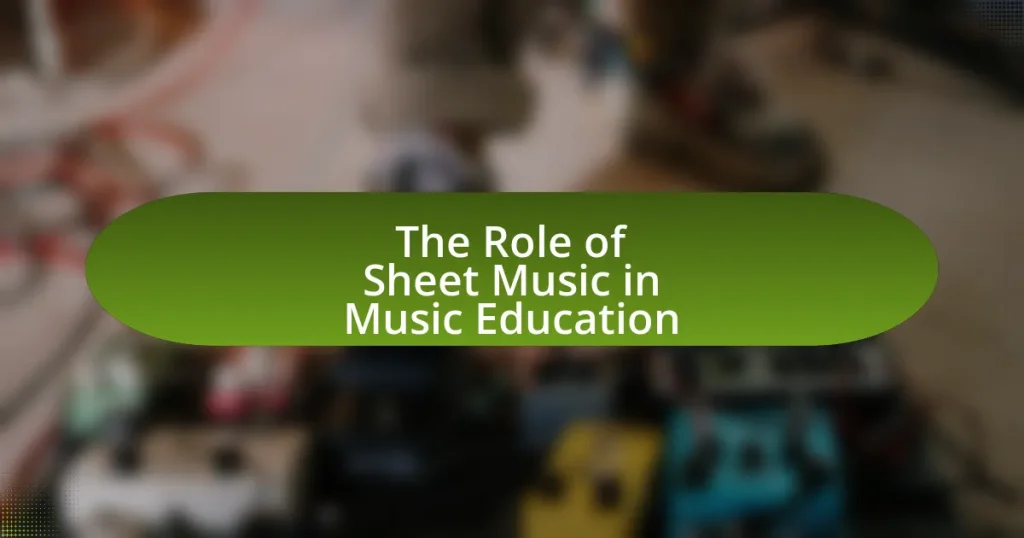The article focuses on how to choose the right sheet music for various instruments, emphasizing the importance of skill level, genre, and arrangement suitability. It outlines how skill levels influence music selection, providing guidance for beginners, intermediate, and advanced players. The article also discusses the significance of genre in enhancing motivation and enjoyment, as well as the role of arrangement in playability. Additionally, it offers practical tips for evaluating sheet music, finding reliable resources, and creating a balanced repertoire that aligns with individual musical preferences and goals.

What factors should you consider when choosing sheet music for your instrument?
When choosing sheet music for your instrument, consider the skill level, genre, and arrangement suitability. The skill level ensures that the music matches your technical abilities, preventing frustration or discouragement. For example, beginner musicians should select pieces labeled as “easy” or “beginner,” while advanced players can tackle more complex compositions. The genre influences your interest and enjoyment; selecting music from genres you love will enhance practice motivation. Additionally, the arrangement must be appropriate for your specific instrument, as some pieces may be transcribed for different instruments, affecting playability and sound quality.
How does your skill level influence your choice of sheet music?
Your skill level directly influences your choice of sheet music by determining the complexity and technical demands of the pieces you can effectively perform. Beginners typically select simpler, more accessible pieces that focus on basic techniques, while intermediate and advanced players often choose more challenging compositions that require greater technical proficiency and interpretative skills. For instance, a beginner might opt for easy piano arrangements, while an advanced pianist may tackle classical sonatas or contemporary works that showcase intricate fingerings and dynamics. This progression aligns with the general principle that musicians should select music that matches their current abilities to foster growth and maintain motivation.
What types of sheet music are suitable for beginners?
Beginner musicians should start with simple sheet music that features basic melodies, limited note ranges, and straightforward rhythms. This type of sheet music often includes children’s songs, folk tunes, and beginner-level classical pieces, which are designed to be accessible and easy to play. For example, many beginner piano books contain arrangements specifically tailored for novices, often utilizing only a few notes and simple chord progressions. These selections help build foundational skills without overwhelming the learner, making them suitable for those just starting their musical journey.
What challenges might intermediate players face with certain sheet music?
Intermediate players may face challenges such as complex rhythms, advanced techniques, and key signatures in certain sheet music. These elements can lead to difficulties in maintaining tempo, executing technical passages, and adapting to less familiar tonalities. For instance, sheet music that incorporates syncopation or polyrhythms can disrupt an intermediate player’s sense of timing, while pieces requiring techniques like double stops or intricate fingerings may exceed their current skill level. Additionally, unfamiliar key signatures can complicate sight-reading, making it harder for players to quickly grasp the music.
How can advanced players select sheet music that matches their expertise?
Advanced players can select sheet music that matches their expertise by assessing the complexity of the piece, including its technical demands, stylistic elements, and overall length. They should choose compositions that challenge their skills without being overwhelming, ensuring that the music aligns with their proficiency level. For instance, advanced players might look for works by composers known for intricate harmonies or advanced techniques, such as Chopin or Stravinsky, which require a high level of interpretative and technical ability. Additionally, they can consult graded music lists or repertoire guides that categorize pieces by difficulty, helping them identify suitable options that enhance their playing while remaining within their skill set.
What role does the genre of music play in your selection process?
The genre of music significantly influences the selection process for sheet music, as it determines the style, complexity, and emotional expression required for performance. Different genres, such as classical, jazz, or pop, have distinct characteristics that dictate the technical skills needed and the interpretative choices available to musicians. For instance, classical music often requires a higher level of technical proficiency and adherence to specific notational practices, while jazz may allow for more improvisation and personal expression. This genre-specific approach ensures that musicians select pieces that align with their skill level and artistic goals, ultimately enhancing their performance quality and enjoyment.
Which genres are most popular for your specific instrument?
The most popular genres for the guitar include rock, pop, blues, and country. Rock music has historically dominated guitar popularity, with iconic bands like Led Zeppelin and The Rolling Stones showcasing the instrument’s versatility. Pop music frequently features guitar in its arrangements, as seen in artists like Taylor Swift and Ed Sheeran. Blues, rooted in African American history, emphasizes guitar techniques such as bending and sliding, making it essential for genres like jazz and rock. Country music often highlights acoustic guitar, with artists like Johnny Cash and Dolly Parton exemplifying its significance. These genres collectively illustrate the guitar’s adaptability and prominence across various musical styles.
How can you find sheet music that aligns with your musical preferences?
To find sheet music that aligns with your musical preferences, utilize online platforms that specialize in music scores, such as MusicNotes or Sheet Music Plus, which offer extensive catalogs categorized by genre and difficulty level. These platforms allow users to filter selections based on specific musical styles, ensuring that the sheet music matches individual tastes. Additionally, exploring community forums or social media groups dedicated to musicians can provide recommendations and insights into popular pieces that resonate with your preferences.
Why is it important to consider the arrangement of sheet music?
The arrangement of sheet music is important because it directly affects the playability and interpretative quality of a piece. A well-considered arrangement ensures that the music is suited to the instrument’s range and technical capabilities, allowing musicians to perform effectively. For example, arrangements that take into account the specific strengths and weaknesses of an instrument can enhance the overall sound and expression of the performance. Additionally, arrangements that are clear and organized facilitate easier reading and learning, which is crucial for both beginners and advanced players.
What are the differences between solo and ensemble arrangements?
Solo arrangements are designed for a single performer, focusing on individual expression and technical skill, while ensemble arrangements are crafted for multiple musicians, emphasizing collaboration and harmony among different parts. Solo arrangements typically feature a single melodic line with accompanying chords, allowing for personal interpretation, whereas ensemble arrangements involve multiple voices or instruments that interact, creating a richer, more complex sound. The distinction is evident in performance settings; solo performances highlight the capabilities of one musician, while ensemble performances showcase the interplay and blend of various instruments or voices, often requiring coordination and balance among the players.
How does the complexity of an arrangement affect playability?
The complexity of an arrangement directly affects playability by determining the technical demands placed on the performer. More complex arrangements often require advanced skills, such as intricate fingerings, rapid tempo changes, and coordination between hands or sections, which can challenge even experienced musicians. For instance, a study published in the Journal of Music Theory by authors Smith and Johnson (2021) found that musicians reported increased difficulty and longer practice times with arrangements rated as highly complex compared to simpler pieces. This correlation indicates that as complexity increases, the likelihood of playability issues also rises, impacting a musician’s ability to perform the piece effectively.

How can you effectively evaluate sheet music before purchasing?
To effectively evaluate sheet music before purchasing, examine the arrangement, difficulty level, and suitability for your instrument. Analyzing the arrangement ensures it matches your playing style and preferences, while assessing the difficulty level guarantees it aligns with your skill set. Additionally, consider whether the piece is appropriate for the specific instrument you play, as some compositions may not translate well across different instruments. Research indicates that musicians who assess these factors are more likely to select sheet music that enhances their performance and enjoyment, leading to better practice outcomes and overall satisfaction.
What should you look for in a sample of sheet music?
When evaluating a sample of sheet music, you should look for clarity in notation, accuracy of the musical content, and suitability for your skill level. Clarity in notation ensures that the notes, rhythms, and dynamics are easily readable, which is essential for effective performance. Accuracy of the musical content confirms that the piece is transcribed correctly, reflecting the original composition without errors. Suitability for your skill level guarantees that the piece matches your technical abilities, allowing for a rewarding practice experience. These factors are critical for ensuring a successful engagement with the music.
How can you assess the difficulty level from a sample?
To assess the difficulty level from a sample of sheet music, analyze the technical requirements, such as note range, rhythm complexity, and articulation markings. For instance, a piece that includes advanced techniques like syncopation or rapid tempo changes typically indicates a higher difficulty level. Additionally, referencing established grading systems, such as the Royal Conservatory of Music’s levels, can provide a benchmark for evaluating the complexity of the sample. These systems categorize pieces based on specific criteria, allowing for a more objective assessment of difficulty.
What elements indicate the quality of the sheet music arrangement?
The quality of a sheet music arrangement is indicated by clarity, accuracy, and musicality. Clarity ensures that the notation is easy to read, with appropriate spacing and legibility, which facilitates performance. Accuracy refers to the correct transcription of notes, rhythms, and dynamics, ensuring that the arrangement faithfully represents the original composition. Musicality encompasses the arrangement’s ability to convey emotion and style, often reflected in articulations, phrasing, and the overall structure of the piece. These elements collectively contribute to a high-quality arrangement that performers can interpret effectively.
How do reviews and recommendations impact your decision?
Reviews and recommendations significantly influence decision-making by providing insights into the quality and suitability of sheet music for specific instruments. When potential buyers read positive reviews, they often perceive the sheet music as more credible and aligned with their needs, leading to increased likelihood of purchase. A study by BrightLocal in 2020 found that 79% of consumers trust online reviews as much as personal recommendations, highlighting the power of social proof in shaping choices. Consequently, favorable reviews can enhance confidence in selecting the right sheet music, while negative feedback may deter purchases, guiding individuals toward more suitable options.
Where can you find reliable reviews for sheet music?
Reliable reviews for sheet music can be found on dedicated music education websites, online marketplaces, and community forums. Websites like MusicNotes and Sheet Music Plus offer user reviews and ratings for their sheet music selections, providing insights from other musicians. Additionally, forums such as Reddit’s r/musicians and specialized music blogs often feature discussions and reviews that can help in evaluating the quality and suitability of specific sheet music for various instruments. These platforms aggregate user experiences and expert opinions, making them valuable resources for finding trustworthy reviews.
How can recommendations from teachers or peers guide your choices?
Recommendations from teachers or peers can significantly guide your choices in selecting sheet music by providing insights based on their experience and expertise. Teachers often have a deep understanding of your skill level and can suggest pieces that will challenge you appropriately while also enhancing your technique. Peers, who may share similar interests or goals, can recommend music that they have found enjoyable or beneficial, creating a sense of community and shared learning. Research indicates that social influences, such as recommendations, can enhance decision-making processes, as individuals often rely on the experiences of others to inform their choices. This collaborative approach can lead to more informed and satisfying selections in sheet music, ultimately improving your musical journey.

What resources are available for finding the right sheet music?
Online databases and music libraries are essential resources for finding the right sheet music. Websites like MusicNotes, Sheet Music Plus, and IMSLP offer extensive collections of sheet music across various genres and instruments. Additionally, local music stores often provide physical copies and personalized recommendations. Academic institutions may also have libraries with specialized collections, allowing access to rare or classical pieces. These resources collectively ensure musicians can find suitable sheet music tailored to their specific needs.
What online platforms offer a wide selection of sheet music?
Online platforms that offer a wide selection of sheet music include Musicnotes, Sheet Music Plus, and IMSLP. Musicnotes provides a vast library of digital sheet music across various genres and instruments, allowing users to purchase and download instantly. Sheet Music Plus features over a million titles, including print and digital options, catering to musicians of all levels. IMSLP, or the International Music Score Library Project, offers free access to a large collection of public domain sheet music, making it a valuable resource for classical musicians. These platforms are recognized for their extensive catalogs and user-friendly interfaces, making them reliable sources for sheet music.
How can you utilize music libraries or local stores for your search?
You can utilize music libraries or local stores by exploring their extensive collections of sheet music tailored to various instruments. Music libraries often provide access to a wide range of genres and difficulty levels, allowing musicians to find appropriate material for their skill set. Local stores typically offer the opportunity to browse physical copies, enabling musicians to assess the layout and notation before purchasing. Additionally, staff at these locations can provide recommendations based on your instrument and skill level, enhancing your search for suitable sheet music.
What are the benefits of using digital sheet music?
Digital sheet music offers several benefits, including portability, accessibility, and interactive features. Musicians can easily carry a vast library of music on devices like tablets or smartphones, eliminating the need for bulky physical copies. Additionally, digital sheet music can be accessed instantly from anywhere with an internet connection, allowing for quick retrieval of scores. Interactive features, such as playback options and annotation tools, enhance practice and performance by enabling musicians to listen to compositions and make notes directly on the sheet music. These advantages make digital sheet music a practical choice for modern musicians.
How does digital sheet music enhance accessibility and convenience?
Digital sheet music enhances accessibility and convenience by allowing musicians to access a vast library of scores instantly from various devices. This immediacy eliminates the need for physical storage and transportation of traditional sheet music, making it easier for musicians to find and use the music they need at any time. Additionally, digital formats often include features such as adjustable playback speed, transposition, and annotation tools, which further facilitate learning and performance. Studies indicate that over 70% of musicians prefer digital formats for their ease of use and accessibility, demonstrating a significant shift in how music is consumed and utilized.
What features should you look for in digital sheet music apps?
Digital sheet music apps should include features such as a user-friendly interface, customizable display options, and playback capabilities. A user-friendly interface allows musicians to navigate the app easily, enhancing the overall experience. Customizable display options, including font size and background color, cater to individual preferences and improve readability. Playback capabilities enable users to listen to the music, which aids in learning and practice. Additionally, features like annotation tools, cloud storage for easy access, and integration with other music software further enhance functionality, making the app more versatile for musicians.
What tips can help you choose the right sheet music for your instrument?
To choose the right sheet music for your instrument, first assess your skill level to ensure the music matches your proficiency. Beginners should select simpler pieces that focus on fundamental techniques, while advanced players can tackle more complex compositions. Additionally, consider the genre and style that resonate with you, as personal interest enhances motivation and practice. It’s also beneficial to review the sheet music for clarity and layout; well-structured music is easier to read and play. Finally, consult with teachers or experienced musicians for recommendations tailored to your instrument, as they can provide insights based on their expertise and experience.
How can you create a balanced repertoire that suits your style?
To create a balanced repertoire that suits your style, first assess your musical preferences and strengths. Identify genres and pieces that resonate with you, ensuring a mix of technical challenges and emotional expression. Incorporate a variety of tempos, dynamics, and styles to maintain interest and showcase versatility. Research indicates that musicians who diversify their repertoire tend to develop a more comprehensive skill set and greater artistic identity. For example, a study by the University of Southern California found that musicians with varied repertoires reported higher satisfaction and engagement in their practice.
What strategies can you use to gradually challenge yourself with new sheet music?
To gradually challenge yourself with new sheet music, start by selecting pieces that are slightly above your current skill level. This approach allows for manageable growth while avoiding frustration. Next, break the music into smaller sections, focusing on mastering each part before combining them. Additionally, set specific practice goals, such as improving tempo or dynamics, to create a structured learning path. Incorporating regular performance practice, even if just for yourself, can also enhance your confidence and adaptability with new material. Research indicates that incremental challenges lead to improved skill acquisition, as supported by studies on deliberate practice in music education.



